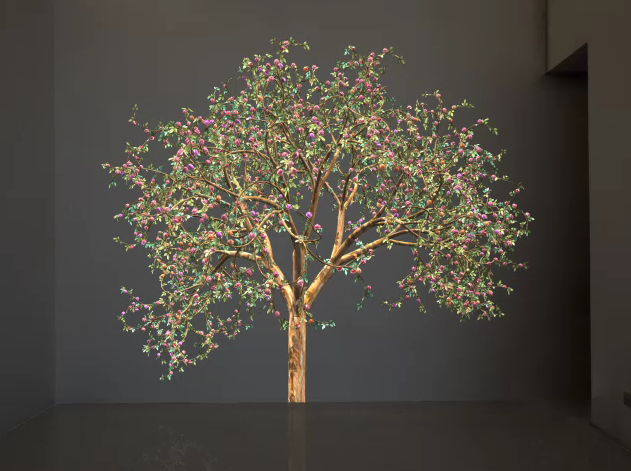Judy Crook 5: Analysis Through Phenomological Methodology
December 3, 2018
by Mercedeh Mirshamsi, Cohort ’16

Judy Crook 5, by Jennifer Steinkamp. Image SourceJudy Crook 5, an installation by media artist Jennifer Steinkamp, is a three dimensional digital animation of a generic tree form projected on the flat surface of a wall. The tree form and its expansive botanical shape is a universal archetype and therefore has a deeply rooted phenomenological significance within the collective consciousness. By encountering a tree shape, one can experience a wide range of emotions, which could always be traced back to a moment of intuitive reflection. The pulsating rhythmic movement of this tree animation overall gave me the experience of a living organism or a living organ such as the beating of the heart in relation to the passing of time.
The continuous transformation and becoming of its trajectory moving from the state of conception with the bare branches to the gradual populating of its leaves and flowers and its eventual shedding of what it bore on its branches created a sense of nostalgia and a strong reference to the impermanent nature of existence. Therefore “time-consciousness” in my experience was the strongest phenomenological attribute of this artwork. This continuous passing of time and constant flux of becoming, is strongly immersive and mesmerizing and even at times hypnotic to encounter, putting one in a meditative state of mind. The rhythmic order of the movement of the tree and its shape remaining intact throughout the process is what gives that feeling of consistency within this continuous state of change. The only element which is universally constant and unchanging in existence, is ‘change’ — a paradoxical fundamental aspect of our reality.
Moreover, in this animation, the tree branches appear to have a consciousness of their own, quite autonomous. They are having an experience of being alive and making a statement to me as the viewer that they are in fact alive. The branches are experiencing the full spectrum of life from birth to death and taking me the spectator on this journey with them and making me ponder over my own impermanence and becoming.
My optical senses were perceiving this digital animation as a three dimensional art object with depth, but I knew intellectually that what I was looking at was completely flat. I had two mental faculties at play at the same time, debating with each other on how I should be experiencing this artwork. From the perspective of an intuitive sense perception, I was witnessing a real tree, three dimensionally with depth which at times I even felt the urge to reach over and touch it, grab its branches or catch its falling leaves. However, my intellect was fighting to convince me, to win me over with fact that what I was in essence looking at is a flat surface and moving digital pixels framed in a grid. It was drawing my attention to the falling leaves, disappearing from sight, going straight into the ground. My intellect was working hard to take away the magic and wonder and the naïveté or the “natural attitude” as described by Husserl, which I was gravitating towards in experiencing this piece. The empirical foreground of the simulation of the three dimensionality of this tree was in a stark contrast with its logical essence of digital flatness against the grid in the background. The very fact that my consciousness had that background information, which was based in logic and quantitative measurement affected my pure empirical and phenomenological experience of it. This makes us question the very validity and precision of a phenomenological art analysis as a whole.
